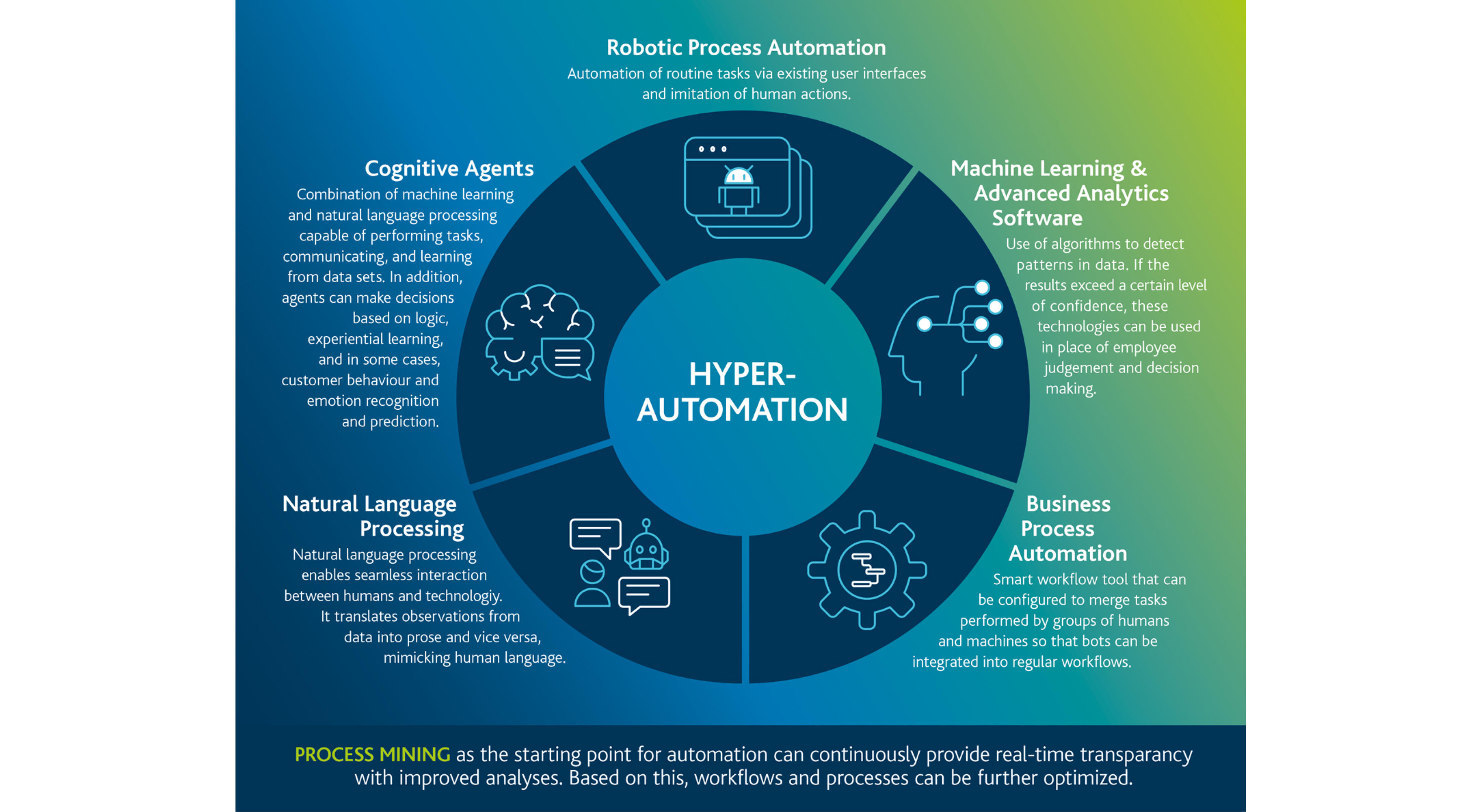
What is Hyperautomation?
Advantages and Benefits for Companies
Hyperautomation is the combination of various technologies for the complete or extensive automation of business processes. These include cognitive technologies such as Artificial Intelligence (AI), machine learning (ML), Robotic Process Automation (RPA), Business Process Management (BPM), chatbots, Natural Language Processing (NLP), and Advanced Analytics. This high-level type of automation is so far-reaching that machines and software are interconnected in a way in which they act almost autonomously. The goal behind hyperautomation is to automate as many processes as possible in an organization to save time and resources.
How Can Hyperautomation Be Used in a Company?
Hyperautomation is a versatile tool that can be applied in many company areas. First of all, already existing processes can be automated. This is done by analyzing which steps are included in a process and which have the highest automation potential. Afterward, the appropriate tools and technologies, such as AI, RPA, NLP, or ML, are selected and implemented. This is followed by testing, acceptance & go-live of the process automation.
Alternatively, it is also possible to implement new processes from scratch. This procedure is called greenfield implementation, which is particularly recommended for new system introductions. This allows companies to rely on automation right from the start.
Hyperautomation is used, among other things, to
- automate business processes
- collect and analyze data
- monitor and control tasks
- create and manage user interfaces
- manage and optimize workflows
- interconnect machines and much more...
Benefits of Hyperautomation for Enterprises
There are several reasons why businesses choose hyperautomation. Some of the benefits of hyperautomation are:
- Time Savings: by automating repetitive tasks, hyperautomation allows companies to speed up processes and save time. As a result, employees have more time to focus on tasks critical to the company's success instead of routine tasks.
- Increased Efficiency: Hyperautomation is a key to efficiency and productivity. A high volume of tasks can be completed in the shortest time and with the lowest error rate thanks to automation, resulting in lower resource consumption. In addition, hyperautomation can be used to analyze complex amounts of data, enabling companies to identify potential improvements to increase efficiency and take the appropriate action.
- Cost Reduction: the possibilities for reducing company costs with hyperautomation are manifold. By implementing hyperautomation, for example, companies can shorten their production cycles and, thus, reduce their production costs. In addition, the use of automation technologies enables higher product quality.
- Better Decision Making: In many companies, a lot of time and energy is still invested in manually collecting and analyzing data. Automation tools allow large amounts of data to be analyzed and processed faster. This gives companies a 360° view of their business, enabling them to identify trends earlier and make more informed strategic decisions.
- More Flexibility: Another reason for implementing hyperautomation is flexibility, which allows companies to respond to rapid changes in market conditions or regulatory changes. Combining different tools and technologies makes it possible to quickly adapt old business processes or implement new process automation. This gives companies the opportunity to introduce new products and services to the market at high speed.

Use Cases of Hyperautomation in Different Industries
Most companies use hyperautomation to increase productivity and reduce costs. By using intelligent systems, companies can make their business processes more efficient and avoid errors. For example, some use cases for the use of hyperautomation can be found in the following industries:
-
Retail & Consumer Goods
The possible applications of hyperautomation in the retail and consumer goods industry are very diverse. For example, hyperautomation can be used to monitor inventories in a system, optimize them automatically, and accelerate order processing. In addition, the technology can be used to automate and increase the efficiency of customer service, marketing, and sales processes: Data-based recommendations, for example, can help in the decision to follow up on specific sales opportunities, thereby reducing sales costs. By combining various automation tools such as Artificial Intelligence (AI), Natural Language Processing (NLP), and Robotic Process Automation (RPA), retail companies also have the opportunity to optimize their chatbots. These bots have the ability to automatically answer customer inquiries and solve problems without the need for human contact.
-
Manufacturing Industry
One example of the use of hyperautomation in the manufacturing industry is the so-called smart factory concept. This approach involves a factory in which machines and systems are networked, and data are exchanged in an automated manner. For example, production errors can be detected more quickly by using optical recognition processes in conjunction with artificial intelligence. Defective parts can be returned to the production process, saving raw materials and avoiding defects that might otherwise only occur later during the use of the parts. The planning and control of the production process are also optimized by networking the machines using hyperautomation. This allows companies to increase productivity and reduce costs.
-
Healthcare
In the healthcare industry, hyperautomation can be used to collect and analyze patient data and monitor treatment processes. By combining AI and machine learning, for example, patterns in large amounts of data can be identified and taken into account when planning treatment. Monitoring vital signs and other health data can also be made more effective through the use of hyperautomation. Technology can thus help improve treatment quality, prevent complications, and reduce treatment costs.
-
Energy Industry
One of the energy industry's biggest challenges is meeting the demand for flexible and secure energy. Here, the availability of power plants plays a crucial role. With the help of hyperautomation, companies can make the control of their power plants more efficient and thus better meet the demand for flexible energy. Another major advantage of hyperautomation is that the technology can contribute to plant safety. By using intelligent sensors, sources of faults can be detected and corrected at an early stage. This approach leads to a long-term reduction in total cost of ownership (TCO).
-
Finance and Accounting
In recent years, automation in finance has developed rapidly. With the introduction of hyperautomation, complex tasks such as creating financial reports, performing the accounting process, payroll process, or compliance checks can now be fully automated. This not only significantly simplifies the work of finance departments but also increases the accuracy and reliability of financial reporting.
-
Logistics
Use cases for hyperautomation in logistics include creating truck routes and providing updates on the vehicle's current location. In addition, automated warehouse management systems or production lines can be developed. Every step in production is automated, from material procurement to manufacturing. Another possible application of hyperautomation in logistics is quality control. Here, complete automation takes place from the inspection of raw materials to the final inspection.
Conclusion
Hyperautomation is not only seen by Gartner as one of the ten most important technology trends but is also one of the most important developments in the corporate world at present and represents the supreme discipline of automation. As a strong driver of innovation and productivity in all industries, it will create completely new opportunities for companies to automate their processes in the future. This means not only a more efficient use of resources but also a significant reduction in costs. Hyperautomation enables companies to focus more on their core competencies and, thus, achieve a significant competitive advantage. At the same time, automation technology paves the way for developing new business models, and hence, adapting to constantly changing market requirements.
Written by

Marc Hübner is the portfolio business owner of Process Automation at Arvato Systems. He has been supporting customers in automation with RPA for over five years. He sees his passion for robots as a digital revolution. He and his team develop virtual agents to automate business processes and increase efficiency.


